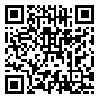Volume 5, Issue 3 (Spring-Special Issue on COVID-19 2020)
Health in Emergencies and Disasters Quarterly 2020, 5(3): 145-154 |
Back to browse issues page
Download citation:
BibTeX | RIS | EndNote | Medlars | ProCite | Reference Manager | RefWorks
Send citation to:



BibTeX | RIS | EndNote | Medlars | ProCite | Reference Manager | RefWorks
Send citation to:
Shariati M, Jahangiri-rad M, Mahmud Muhammad F, Shariati J. Spatial Analysis of COVID-19 and Exploration of Its Environmental and Socio-Demographic Risk Factors Using Spatial Statistical Methods: A Case Study of Iran. Health in Emergencies and Disasters Quarterly 2020; 5 (3) :145-154
URL: http://hdq.uswr.ac.ir/article-1-297-en.html
URL: http://hdq.uswr.ac.ir/article-1-297-en.html
1- Department of Environmental Planning, College of Engineering, Faculty of Environment, Management and Education, University of Tehran, Tehran, Iran.
2- Department of Environmental Hygiene, School of Health and Medical Engineering and Psychology, Tehran Medical Sciences Branch, Islamic Azad University, Tehran, Iran.
3- Department of Epidemiology, School of Public Health, Tehran University of Medical Sciences, Tehran, Iran.
4- Department of Chemical Engineering, Darab Branch, Islamic Azad University, Darab, Iran.
2- Department of Environmental Hygiene, School of Health and Medical Engineering and Psychology, Tehran Medical Sciences Branch, Islamic Azad University, Tehran, Iran.
3- Department of Epidemiology, School of Public Health, Tehran University of Medical Sciences, Tehran, Iran.
4- Department of Chemical Engineering, Darab Branch, Islamic Azad University, Darab, Iran.
Abstract: (2959 Views)
Background: Iran detected its first COVID-19 case in February 2020 in Qom province, which rapidly spread to other cities in the country. Iran, as one of those countries with the highest number of infected people, has officially reported 1812 deaths from a total number of 23049 confirmed infected cases that we used in the analysis.
Materials and Methods: Geographic distribution by the map of calculated incidence rates for COVID -19 in Iran within the period was prepared by GIS 10.6 Spatial autocorrelation (Global Moran’s I) and hot spot analysis were used to assess COVID -19 spatial patterns. The ordinary least square method was used to estimate the relationship between COVID -19 and the risk factors. The next step was to explore Geographically Weighted Regression (GWR) models that might better explain the variation in COVID -19 cases based on the environmental and socio-demographic factors.
Results: The spatial autocorrelation (Global Moran’s I) result showed that COVID-19 cases in the studied area were in clustered patterns. For statistically significant positive z-scores, the larger the z-score is, the more intense the clustering of high values (hot spot), such as Semnan, Qom, Isfahan, Mazandaran, Alborz, and Tehran. Hot spot analysis detected clustering of a hot spot with confidence level 99% for Semnan, Qom, Isfahan, Mazandaran, Alborz, and Tehran, as well. The risk factors were removed from the model step by step. Finally, just the distance from the epicenter was adopted in the model. GWR efforts increased the explanatory value of risk factor with better special precision (adjusted R-squared=0.44)
Conclusion: The highest CIR was concentrated around Qom. Also, the greater the distance from the center of prevalence (Qom), the fewer the patients. Hot spot analysis also implies that the neighboring provinces of prevalence centers exhibited hot spots with a 99% confidence level. Furthermore, the results of OLS analysis showed the significant correlation of CIR is with the distance from epicenter (Qom). The GWR can result in the spatial granularity providing an opportunity to well understand the relationship between environmental spatial heterogeneity and COVID-19 risk as entailed by the infection of CIR with COVID-19, which would make it possible to better plan managerial policies for public health.
Materials and Methods: Geographic distribution by the map of calculated incidence rates for COVID -19 in Iran within the period was prepared by GIS 10.6 Spatial autocorrelation (Global Moran’s I) and hot spot analysis were used to assess COVID -19 spatial patterns. The ordinary least square method was used to estimate the relationship between COVID -19 and the risk factors. The next step was to explore Geographically Weighted Regression (GWR) models that might better explain the variation in COVID -19 cases based on the environmental and socio-demographic factors.
Results: The spatial autocorrelation (Global Moran’s I) result showed that COVID-19 cases in the studied area were in clustered patterns. For statistically significant positive z-scores, the larger the z-score is, the more intense the clustering of high values (hot spot), such as Semnan, Qom, Isfahan, Mazandaran, Alborz, and Tehran. Hot spot analysis detected clustering of a hot spot with confidence level 99% for Semnan, Qom, Isfahan, Mazandaran, Alborz, and Tehran, as well. The risk factors were removed from the model step by step. Finally, just the distance from the epicenter was adopted in the model. GWR efforts increased the explanatory value of risk factor with better special precision (adjusted R-squared=0.44)
Conclusion: The highest CIR was concentrated around Qom. Also, the greater the distance from the center of prevalence (Qom), the fewer the patients. Hot spot analysis also implies that the neighboring provinces of prevalence centers exhibited hot spots with a 99% confidence level. Furthermore, the results of OLS analysis showed the significant correlation of CIR is with the distance from epicenter (Qom). The GWR can result in the spatial granularity providing an opportunity to well understand the relationship between environmental spatial heterogeneity and COVID-19 risk as entailed by the infection of CIR with COVID-19, which would make it possible to better plan managerial policies for public health.
Type of Study: Case Report |
Subject:
Special
Received: 2020/03/10 | Accepted: 2020/03/23 | Published: 2020/04/1
Received: 2020/03/10 | Accepted: 2020/03/23 | Published: 2020/04/1
| Rights and permissions | |
 |
This work is licensed under a Creative Commons Attribution-NonCommercial 4.0 International License. |








